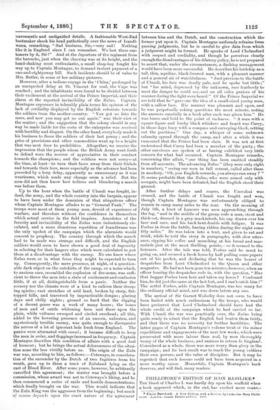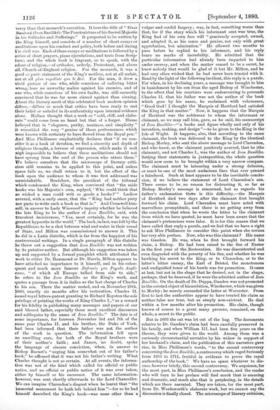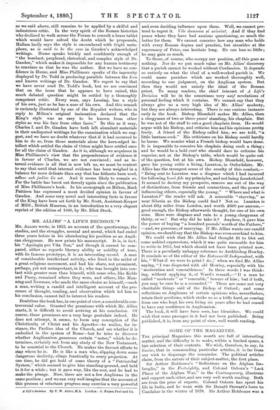PHILLIMORE'S EDITION OF ICON BASILIKE. , THE blood of Charles I.
was hardly dry upon his scaffold when a book appeared which, in the end, has excited more contrc- • Eix..er BartAss4. A New FAJI'on, wihh a PseGee by Collie' ine Mary PUN- more. London: James Parker and Co. 1579. versy than that monarch's execution. It bore the title of " Men. Becorxra4 (Icon Basilik4) : The Ponrtraicture of his Sacred Majestie in his Solitudes and Sufferings." It purported to be written by the King himself, and consists of a number of short essays or meditations upon his conduct and policy, both before and during Cie civil war. Each of these essays or meditations is followed by a series of short prayers, pions ejaculations, and texts from Scrip- ture; and the whole book is fragrant, so to speak, with the odour of religion,—of orthodox, orderly, Protestant, and above all, Church-of-England religion. For the monarch, it was a good ex parte statement of the King's motives, not at all unfair, not at all plus royalists que is Boi. For the man, it drew a vivid picture of one who, while conscious of suffering bitter wrong, bore no unworthy malice against his enemies, and of one who, while conscious of his own faults, was still earnestly convinced that he was far more sinned against than sinning. About the literary merit of this celebrated book modern opinion differs,—differs so much that critics have been ready to rest their belief or unbelief in its authenticity upon internal evidence alone. Hallam thought that a work so "cold, stiff, and elabo- rate" could come from no hand but that of a forger. Hume believed that in "elegance, purity, neatness, and simplicity" it resembled the very " genius of those performances which were known with certainty to have flowed from the Royal pen." And Miss Phillimore emphatically declares that " if we con- sider it as a book of devotion, we find a sincerity and depth of religious thought, a fervour of expression, which make it well nigh impossible to believe that these meditations should not have sprung from the soul of the person who utters them." We believe ourselves that the microscope of literary criti- cism still remains to be applied to this point, and unless space fails us, we shall return to it, but the effect of the book upon the audience to whom it was first addressed was unmistakable. Bradshaw, the president of the tribunal which condemned the King, when convinced that " the snide booke was his Majestie's own, replyed, Who could think that so wicked a man could writ so goode a booke ?' " Ludlow averred, with .a surly sneer, that the " King had neither piety w nor parts to write such a book as that is." And Cromwell him- self, in answer to Lady Winwood's inquiry whether he believed the late King to be the author of Icon Basilike, said, with truculent decisiveness, " Yes, most certainly, for he was the greatest hypocrite in the world." The book, in fact, was felt by the Republicans to be a shot between wind and water in their vessel of State, and Milton was commissioned to answer it. This he did in a Latin diatribe, which is far from the happiest of his controversial writings. In a single paragraph of this diatribe he threw out a suggestion that Icon Basilike was not written by its putative author. But although his suggestion was taken up and supported by a formal pamphlet which attributed the work to either Dr. Hammond or Dr. Harris, Milton appears to have attached no importance to it himself, and in his subse- quent and much more famous Defensio pro Populo Angli- can°, " of which all Europe talked from side to side," he refers to 'the Icon Basilike as the King's work, and quotes a passage from it in italics as the lust charge of Charles to his son. There the matter rested, and on November 29th, 1660, exactly six months after his restoration, Charles II. issued royal letters-patent granting to Richard Royston the sole privilege of printing the works of King Charles I.," as a reward for his fidelity in publishing many messages and papers of our said blessed father, especially those most excellent discourses and soliloquies by the name of Icon Basilike." The date is of some importance, for between November 3rd and 7th of the same year Charles II. and his brother, the Duke of York, had been informed that their father was not the author of the work in question. The information fell upon no unwilling ears, for both of the Royal brothers were of their mother's faith ; and James, no doubt, spoke the language of sincere conviction, when, in answer to Bishop Burnet's "urging him somewhat out of his father's book," he affirmed that it was not his father's writing. What Charles thought is not so certain. At all events, the informa- tion was not of the kind which called for official or public notice, and no official or public notice of it was ever taken, either by himself or his successor. The same information, however, was sent shortly afterwards to the Lord Chancellor. We can imagine Clarendon's disgust when he learnt that "the immortal monument he hath left behind him "—for so he had himself described the King's book—was none other than' a vulgar and sordid forgery ; was, in fact, something worse than that, for if the story which his informant sent was true, the King had of his own free will " graciously accepted, owned, and adopted it, as his sense and genius, not only with great approbation, but admiration." He allowed two months to pass before he replied to his informant, and his reply bears no marks of incredulity. He admitted that the particular information had already been imparted to him under secresy, and when the matter ceased to be a secret, he knew nobody that would be glad of it but Mr. Milton, and he had very often wished that he had never been trusted with it. Read by the light of the following incident, this reply is a puzzle. For when, in his declining years, a message was brought to him in banishment by his son from the aged Bishop of Winchester, to the effect that his courtiers were endeavouring to persuade Charles IL that his father was not the author of the book which goes by his name, he exclaimed with vehemence, " Good God ! I thought the Marquis of Hertford had satisfied the King in that matter." Now, it happens that the Marquis of Hertford was the nobleman to whom the informant or claimant, as we may call him, gave, as he said, his manuscript of Icon Basilike—" a booke and figure wholly and only of his invention, making, and design "—to be given to the King in the Isle of Wight. It happens, also, that according to the same claimant, the book was delivered to the King by the identical. Bishop Morley, who sent the above message to Lord Clarendon, and who knew, so the claimant positively averred, that he (the claimant), and not Charles I., was the author of Icon Basilike. Setting their statements in juxtaposition, the whole question would now seem to be brought within a very narrow compass. The claimant must be labouring under a strong delusion, or must be one of the most audacious liars that ever penned a falsehood. Such at least appears to be the inevitable conclu- sion, if we believe the statement of Lord Clarendon's son. There seems to be no reason for distrusting it, so far as Bishop Morley's message is concerned, but as regards his father's exclamation there is this difficulty,—the Marquis of Hertford died two days after the claimant first brought forward his claim. Lord Clarendon must have acted with marvellous promptitude, and there is no getting away from the conclusion that when he wrote the letter to the claimant from which we have quoted, he must have been aware that the claimant's pretensions were false. It is for this reason that we have called that reply a puzzle, and we feel that we have a right to ask Miss Phillimore to consider this point when she revises her very able preface. Now, who was this claimant? His name was Gauden. He was, when he first brought forward his claim, a Bishop. He had been raised to the See of Exeter in the first year of the Restoration. He was discontented and even disgusted with the poverty of his See, and whether he was hawking his secret to the King, or to Clarendon, or to the latter's bitter enemy, the Earl of Bristol, the monotonous and undignified tenor of his howls was for promotion. It came at last, but not in the shape that he desired, not in the shape, perhaps, that he deserved, if he were the admitted author of Icon Basilike. On the death of Dr. Duppa, Ganden was not promoted to the coveted object of his ambition, Winchester, which was given to Morley; he merely succeeded the latter at Worcester. From first to last the authorities appear to have treated his claim as neither false nor true, but as simply non-existent. He died within a few months after his promotion. His claim, though known of course to a great many persons, remained, on the whole, a secret to the public.
But in 1693 the cat was let out of the bag. The documents relative to Dr. Gauden's claim had been carefully preserved in his family, and when William III. had been five years on the throne, they were given to the world. Among them was a curiously circumstantial narrative by his widow in support of her husband's claim, and the publication of this narrative gave rise, in Miss Phillimore's words, " to the second controversy concerning the Icon Basilike, a controversy which raged furiously from 1693 to 1711, fruitful in evidence to prove the royal authorship of the book." We have no space whatever to dia., cuss, however briefly, this second controversy. We acquiesce, for the most part, in Miss Phillimore's conclusion, and the reader who will turn to her preface will find much that is amusing and dramatic, and much also that is perplexing, in the details which are there narrated. They are taken, for the most part, from Dr. Wordsworth's elaborate work, but we cannot say the discussion is finally closed. The microscope of literary criticism, as we said above, still remains to be applied by a skilful and industrious critic. In the very spirit of the Roman historian who declined to walk across the Forum to consult a brass tablet which would have solved the doubt which he propounds, Hallam lazily says the style is encumbered with frigid meta- phors, as is said to be the case in Gauden's acknowledged writings. Hume speaks briskly and confidently enough of " the bombast, perplexed, rhetorical, and complex style of Dr. Gauden," which makes it impossible for any human testimony to convince us that he was the author. But we have no con- fidence in Hume, and Miss Phillimore speaks of the ingenuity displayed by Dr. Todd in producing parallels between the Icon and known writings of Dr. Gauden. We regret to say that we have never read Dr. Todd's book, but we are convinced that on the issue that he appears to have raised, this much debated question might be settled by a thoroughly competent critic. Every man, says Lessing, has a style of his own, just as he has a nose of his own. And this remark is curiously illustrated by one of the Royalist writers, who in reply to Milton's original insinuation declared that the King's style was as easy to be known from other styles as was his face from other faces." Be this as it may, Charles I. and Dr. Gauden have both left abundant materials in their undisputed writings for the examination which we sug- gest, and we have no doubt whatever that if it had occurred to him to do so, from those materials alone the keen-edged in- tellect which settled the claim of Orton might have settled once for all the claim of Gauden. As it is, although we acquiesce in Miss Phillimore's view that the preponderance of evidence is in favour of Charles, we are not convinced ; and as in- ternal evidence is all that is now left as, we must be content to say that until that internal evidence has been weighed in a balance far more delicate than any that has hitherto been used, adhuc sub juelice lie est. And it seems likely to remain so. For the battle has burst out fiercely again since the publication of Miss Phillimore's book. In his monograph on Milton, Mark Pattison has expressed a most decided opinion in favour of Gauden. And some very novel and interesting facts in favour of the King have been set forth by Mr. Scott, Assistant-Keeper of MSS., British Museum, in an introduction to a very elegant reprint of the edition of 1648, by Mr. Eliot Stock.




































 Previous page
Previous page